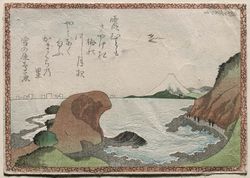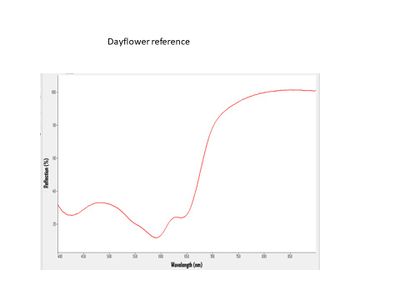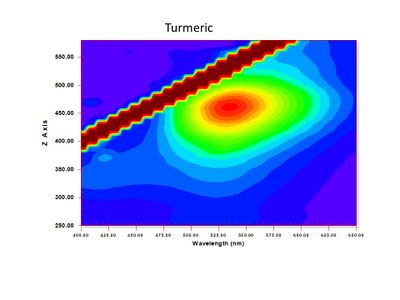Difference between revisions of "Category:Dayflower/Turmeric: Ukiyo-e colorant"
| (10 intermediate revisions by the same user not shown) | |||
| Line 2: | Line 2: | ||
[[File:SC155045.jpg|right|250px|link=https://collections.mfa.org/objects/207552/kamakura-village-from-an-untitled-series-of-westernstyle-l?ctx=1be86594-d25a-458d-827f-8e5dc3048977&idx=0|Kamakura Village by Katsushika Hokusai]] | [[File:SC155045.jpg|right|250px|link=https://collections.mfa.org/objects/207552/kamakura-village-from-an-untitled-series-of-westernstyle-l?ctx=1be86594-d25a-458d-827f-8e5dc3048977&idx=0|Kamakura Village by Katsushika Hokusai]] | ||
| − | <font size="3">'''[[:Category:Dayflower: Ukiyo-e colorant|Dayflower]] + [[:Category:Turmeric: Ukiyo-e colorant|Turmeric]]'''</font>: Dayflower | + | <font size="3">'''[[:Category:Dayflower: Ukiyo-e colorant|Dayflower]] + [[:Category:Turmeric: Ukiyo-e colorant|Turmeric]]'''</font>: Green is achieved by overprinting or mixing a blue and a yellow colorant. Dayflower printed over turmeric was typically used on early prints of two to three colors. On prints the appearance of green produced by overprinting turmeric with dayflower can change upon exposure to moisture or fading. The highly water soluble dayflower can move towards the back of the paper support to reveal the yellow turmeric. Turmeric is also highly susceptible to fading and in some cases the green produced by the combination of these two colors can appear tan. Later, the dayflower+turmeric mixture was largely supplanted by [[:Category:Indigo/Orpiment: Ukiyo-e colorant|indigo+orpiment]] which becomes the dominate formulation for green. |
| − | |||
'''For more information see:''' [[:Category:Dayflower: Ukiyo-e colorant|Dayflower]], [[:Category:Turmeric: Ukiyo-e colorant|Turmeric]] | '''For more information see:''' [[:Category:Dayflower: Ukiyo-e colorant|Dayflower]], [[:Category:Turmeric: Ukiyo-e colorant|Turmeric]] | ||
<br> | <br> | ||
| + | |||
| + | |||
== Examples of Dayflower+Turmeric in Ukiyo-e Prints == | == Examples of Dayflower+Turmeric in Ukiyo-e Prints == | ||
| Line 42: | Line 43: | ||
== Analysis == | == Analysis == | ||
| − | Excitation Emission Matrix (EEM) spectroscopy | + | Fiber optic reflectance spectroscopy (FORS) is used to identify [[:Category:Dayflower: Ukiyo-e colorant|dayflower]] and Excitation Emission Matrix (EEM) spectroscopy [[:Category:Turmeric: Ukiyo-e colorant|turmeric]]. |
| + | |||
<gallery mode="packed" heights="200px" style="text-align: left"> | <gallery mode="packed" heights="200px" style="text-align: left"> | ||
| + | Dayflower FORS.JPG|<center>FORS spectrum of Dayflower reference</center> | ||
Turmeric EEM ref.jpg|<center>3D EEM plot for Turmeric</center> | Turmeric EEM ref.jpg|<center>3D EEM plot for Turmeric</center> | ||
| − | |||
</gallery> | </gallery> | ||
==List of Prints == | ==List of Prints == | ||
| − | + | Below is a list of prints where dayflower + turmeric was detected. | |
Revision as of 00:31, 27 July 2020
Dayflower + Turmeric: Green is achieved by overprinting or mixing a blue and a yellow colorant. Dayflower printed over turmeric was typically used on early prints of two to three colors. On prints the appearance of green produced by overprinting turmeric with dayflower can change upon exposure to moisture or fading. The highly water soluble dayflower can move towards the back of the paper support to reveal the yellow turmeric. Turmeric is also highly susceptible to fading and in some cases the green produced by the combination of these two colors can appear tan. Later, the dayflower+turmeric mixture was largely supplanted by indigo+orpiment which becomes the dominate formulation for green.
For more information see: Dayflower, Turmeric
Examples of Dayflower+Turmeric in Ukiyo-e Prints

|

|

|

|

|
Analysis
Fiber optic reflectance spectroscopy (FORS) is used to identify dayflower and Excitation Emission Matrix (EEM) spectroscopy turmeric.
List of Prints
Below is a list of prints where dayflower + turmeric was detected.
Pages in category "Dayflower/Turmeric: Ukiyo-e colorant"
The following 2 pages are in this category, out of 2 total.



